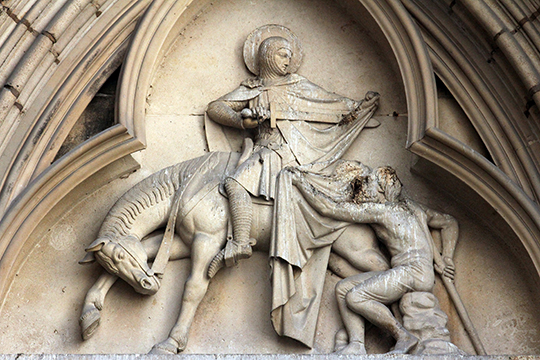Reflections on Life
By Melvin Arrington
Why is the life of a saint who died more than 1,600 years ago relevant to us today? In other words, why does St. Martin of Tours (315 to 397) still matter? The short answer is because his was a life well lived. There is much we can learn from him about respecting the dignity of each person and about practicing the church’s preferential option for the poor.

Born into a pagan family in present-day Hungary and raised in what is now Italy, Martin enrolled as a catechumen at a tender age. His father, an officer in the Imperial Roman army, wanted his son to pursue a military career, but Martin had no interest in becoming a soldier. Nevertheless, he was conscripted into the army. At age eighteen he was baptized. Two years later he left the military, proclaiming: “I am a soldier of Christ; it is not lawful for me to fight.” Interestingly, Martin’s feast day, Nov. 11, is also Veterans Day, which honors all who have served in the military and, additionally, commemorates the signing of the Armistice that ended fighting in World War I.
After leaving the army, Martin met Hilary, Bishop of Poitier, who encouraged the young man to return to Italy to try to win over his family and friends to the Christian faith. But upon arriving there he found himself surrounded by followers of the Arian heresy. After struggling to convert the Arians, Martin returned to Gaul (France) and established a monastery near Poitiers, where he gathered a group of followers and began preaching throughout the area. Because of his holiness, asceticism, and reputation as a miracle worker, the people elected him Bishop of Tours.
Martin founded many churches and monasteries and became a strong defender of the faith, fighting pagans and heretics with words rather than the sword. Known for his compassion, he became an early opponent of the death penalty and often pled for mercy on behalf of those condemned to death.
Because of Martin’s renown as a healer, people with various diseases and disorders came to him seeking cures, among them a leper, a paralytic, and a woman with an issue of blood. He also drove out evil spirits from the demon possessed and raised the dead. Those in the latter category included a man who had died without baptism, another who had hanged himself, and a third man, whose resuscitation resulted in the conversion a large crowd of pagans who had witnessed the miracle. Once, when a pagan attempted to behead him, the sword separated itself from the would-be assassin’s hand and fell harmlessly to the ground.

The most memorable incident in this great saint’s life occurred in the city of Amiens during his stint in the army. On a cold winter’s day as Martin was riding through the gate leaving the city, he encountered a practically naked beggar who was freezing from the cold. Deeply moved by the poor man’s suffering, the young soldier took his sword in hand, cut his cloak in two, and gave half to the poor stranger. That night Martin experienced a vision of Christ clothed in the portion of the cloak he had given to the beggar.
This great act of charity, immortalized in El Greco’s painting “St. Martin and the Beggar” and Van Dyck’s “St. Martin Dividing His Cloak,” brings to mind the admonition: “Whoever has two tunics should share with the person who has none.” (Luke 3:11) St. Ambrose, a contemporary of St. Martin, expressed it this way: “If you have two shirts in your closet, one belongs to you and the other to the man with no shirt.”
I like to think St. Martin had so internalized the teachings of Matthew 25 that he helped the beggar because charity was second nature to him. In Matthew 25:34-40 Jesus tells the blessed they will inherit the kingdom because they came to his aid when He was in need; among other things, He was naked and they clothed Him. These righteous ones, not realizing what Jesus meant, question Him about it, implying that they really didn’t do anything at all for their Lord. Then the King of Kings replies: “Amen, I say to you, whatever you did for one of these least brothers of mine, you did for me.”
How should we respond to the plight of the poor? Of course, we should pray for them, but that’s not enough. We must put our faith in action by performing the corporal works of mercy. Specifically, we are called to feed the hungry, give drink to the thirsty, welcome the stranger, clothe the naked, care for the sick, and visit the prisoner. This is what St. Paul meant by “faith working through love.” (Galatians 5:6b)
With so many needs and so many opportunities for giving of our time and resources, it shouldn’t be hard to find ways to follow St. Martin’s example. Contributing to relief efforts for those attempting to put their lives back together in the wake of the recent hurricanes is just one way. If we open our eyes and ears, the needs in our local communities will become readily apparent to us.
St. Martin of Tours, the soldier who didn’t want to fight, was one of the first holy persons to become a saint without being martyred. His abiding concern for the poor, the sick, and the imprisoned made him a model of compassion for his generation and an inspiration to Christians across the centuries. May this “soldier of Christ” inspire in us a fervent desire to become models of “faith working through love.”
(Melvin Arrington is a Professor Emeritus of Modern Languages for the University of Mississippi and a member of St. John Oxford.)
